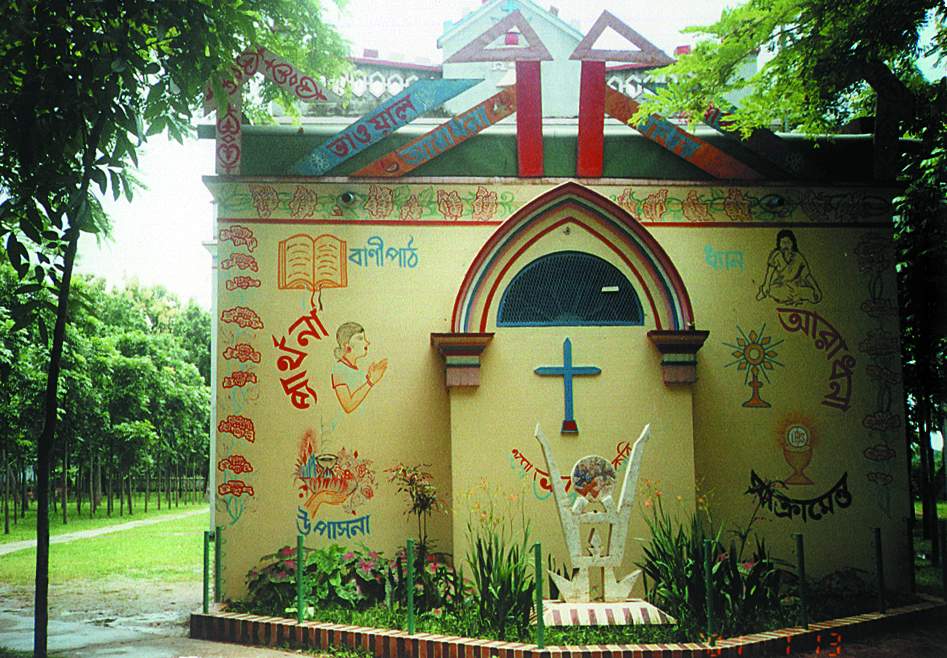|

In 1695, the church of St. Nicholas of Tolentino was constructed at Nagori, 25 kilometres northeast of Dhaka. In 1764, Portuguese
missionaries built a church at Padrishibpur in Barisal district. Another Portuguese church was built at Hashnabad, 30 kilometers
southwest of Dhaka, in 1777. In 1682, there were 14,120 Roman Catholics in the Bangladesh territory.
As the Bangladeshi
Muslims have Arabic and Persian surnames, so do the Portuguese-converted Catholics have Portuguese surnames, such as Gomes,
Rozario, DRozario, Cruze, DCruze, Dores, DSilva, DSouza, Costa, DCosta, Palma, Pinheiro, Pereira Rego, Ribeiro, Rodrigues,
Serrao, Gonsalves, Corraya, etc. To recognize Catholics by names, the missionaries used to give one Christian name and one
of their surnames to the newly baptized person. The later Catholic missionaries from France, USA, Canada, and Italy did not
follow the Portuguese in naming the new Christians. They gave one Christian name but did not change the surname of the newly
convert.
Presently, the Catholic Church has six dioceses Dhaka, Chittagong, Dinajpur, Khulna, Mymensngh, and Rajshahi
with a Catholic population of about 221,000, more than 70 parish churches, 200 priests, 50 Brothers, 700 nuns, 1,000 catechists,
and many educational, healthcare, and welfare institutions and organizations.
With each challenge we have encountered,
we became stronger in our faith. We may provide links to other sites that provide more detail on our church history or particular
events in our past.
We invite you to become a part of the church today and a piece of its history tomorrow.
Christianity in Bangladesh
Christianity's first contact with the Indian subcontinent is attributed to the Apostle Thomas, who is said to have preached
in southern India. Although Jesuit priests were active at the Mughal courts in the sixteenth and seventeenth centuries, the
first Roman Catholic settlements in what became Bangladesh appear to have been established by the Portuguese, coming from
their center in Goa on the west coast of India. During the sixteenth century the Portuguese settled in the vicinity of Chittagong,
where they were active in piracy and slave trading. In the seventeenth century some Portuguese moved to Dhaka.
Serious
Protestant missionary efforts began only in the first half of the nineteenth century. Baptist missionary activities beginning
in 1816, the Anglican Oxford Mission, and others worked mainly among the tribal peoples of the Low Hills in the northern part
of Mymensingh and Sylhet regions. Many of the Christian churches, schools, and hospitals were initially set up to serve the
European community. They subsequently became centers of conversion activities, particularly among the lower caste Hindus.
The Ministry of Religious Affairs provided assistance and support to the Christian institutions in the country.
In the late 1980s, the government was not imposing any restrictions on the legitimate religious activities of the missions
and the communities. Mission schools and hospitals were well attended and were used by members of all religions. The Christian
community usually enjoyed better opportunities for education and a better standard of living. In the late 1980s, Christianity
had about 600,000 adherents, mainly Roman Catholic, and their numbers were growing rapidly.
Data as of September
1988
Direction-how would you go to Nagari
If you like to go to Nagari, you have to go Tongi-station road first. Then you take a bus, tempo, or Taxi and you have to
go upto Nalsata Station. Now you ride on Rickshaw. From Tongi to Nalsata Station about 10 K.m. distance. From Nalsata to Nagari
there is about 2 k.m. road.
After arriving to Nagari you will get easily the said places.
St. Nicholas of Tolentino

Life History
Born at Sant' Angelo, near Fermo, in the March of Ancona, about 1246; d. 10 September, 1306. He is depicted in the black habit
of the Hermits of St. Augustine -- a star above him or on his breast, a lily, or a crucifix garlanded with lilies, in his
hand. Sometimes, instead of the lily, he holds a vial filled with money or bread. His parents, said to have been called Compagnonus
de Guarutti and Amata de Guidiani (these surnames may merely indicate their birth-places), were pious folk, perhaps gentle
born, living content with a small substance. Nicholas was born in response to prayers, his mother a model of holiness. He
excelled so much in his studies that even before they were over he was made a canon of St. Saviour's church; but hearing a
sermon by a hermit of St. Augustine upon the text: "Nolite diligere mundum, nec ea quae sunt in mundo, quia mundus transit
et concupiscentia ejus", he felt a call to embrace the religious life. He besought the hermit for admittance into his
order. His parents gave a joyful consent. Even before his ordination he was sent to different monasteries of his order, at
Recanati, Macerata etc., as a model of generous striving after perfection. He made his profession before he was nineteen.
After his ordination he preached with wonderful success, notably at Tolentino, where he spent his last thirty years and gave
a discourse nearly every day. Towards the end diseases tried his patience, but he kept up his mortifications almost to the
hour of death. He possessed an angelic meekness, a guileless simplicity, and a tender love of virginity, which he never stained,
guarding it by prayer and extraordinary mortifications. He was canonized by Eugene IV in 1446; his feast is celebrated on
10 September. His tomb, at Tolentino, is held in veneration by the faithful.
Acta SS., Sept. III, 636; BUTLER, Lives of the Saints, III (Baltimore), 440; HAGELE in Kirchenlex., s.v.
EDWARD
F. GARESCHE
Transcribed by Thomas M. Barrett
Dedicated to St. Nicholas
The Catholic Encyclopedia,
Volume XI
Copyright 1911 by Robert Appleton Company
Online Edition Copyright 1999 by Kevin Knight
Nihil
Obstat, February 1, 1911. Remy Lafort, S.T.D., Censor
Imprimatur. +John Cardinal Farley, Archbishop of New York
|

